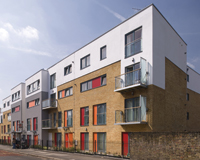 Affordable housing is a long-established category in the UK residential landscape yet it remains one of the most ill-defined areas for the potential investor.
Affordable housing is a long-established category in the UK residential landscape yet it remains one of the most ill-defined areas for the potential investor.
For decades the sector has been identified with publicly funded homes to rent, built and managed by not-for-profit local authorities or so-called “registered providers” such as housing associations.
Now the government wants to be more specific about the sector by giving “affordable housing” a precise definition while at the same time broadening the sector’s remit to include privately built and managed homes.
Even so, the new definition as set out on the government’s own website is still hard to pin down. It reads: “Affordable housing includes social rented, affordable rented and intermediate housing, provided to specified eligible households whose needs are not met by the market. It can be a new-build or a private sector property purchased for use as an affordable home.”
Such vagueness has its merits. The potential for investors to try different models is considerable, as private fund operators Salamanca Group, Cheyne Capital, L&G and others have realised (see box) in a flurry of deals undertaken in the past two years.
But there are constraints, too.
“To date, private investment has been overwhelmingly through bank debt, bond issuance and placements on capital markets. The absence of an equity component in the financial structure of not-for-profit affordable housing providers has limited direct investment to leaseback deals and a few peripheral vehicles,” explains Mervyn Jones, a director in Savills’ consultancy team.
Investors wanting a clear exit strategy may also be discouraged. “Planning agreements… typically require affordable housing to be provided ‘in perpetuity’ which is normally taken to be a 99-year lease. Therefore, many investors opt for more liquid forms such as bonds issued by registered providers [of housing],” says Anthony Lee, head of viability services at BNP Paribas Real Estate.
Even so, the affordable sector has obvious attractions. Catherine Raynsford, residential director at JLL, says they include the multiple deals which many registered providers want and which cut investors’ costs of entry; secure index-linked income streams; and the low default risk because most registered providers have local or national government backing.
She also highlights that previously off-putting characteristics of the sector – such as frequent political interference and a cultural distaste for private funding by some providers – may change thanks to the far-reaching Housing and Planning Bill likely to become law in mid-2016. “Among these is deregulation and the potential opportunities this may present for investors,” she says.
Raynsford also points to the scale of opportunity. No city in the UK has sufficient housing stock to meet the demands of a fast-expanding population, so affordable investment could take place almost anywhere. A few councils with enhanced devolved powers – notably Manchester and London – have recently increased delivery targets for affordable housing.
A declaration by prime minister David Cameron that he wants public and private funding to demolish up to 100 ‘brutalist’ council estates and replace them with modern homes is likely to produce more affordable housing potential when details are fleshed out.
For pioneering investors, the rewards look high and long lasting. After all, even a recent house-building spurt has resulted in about 155,000 units built per year, when 235,000 are needed, so the hunger for affordable homes is unlikely to be satisfied any time soon.
That seems like quite an investment opportunity, by any definition.
Four investors in affordable housing
Cheyne Capital
In 2014 equity investor Cheyne Capital created a Property Impact Fund to contribute to an £8.5m scheme in which Lindum Construction will build 80 affordable homes for Luton Borough Council by late 2016. The fund purchased the site from the local authority after securing planning consent and Cheyne Capital says the long-term return is seen as low risk because of the reliably strong demand into the future.
Hearthstone Investments
Places For People, which already manages 140,000 UK homes – mostly affordable – has agreed a £15m loan facility from Hearthstone-managed pension funds for homes to be built and managed by Scottish housing association Castle Rock Edinvar. Hearthstone says ultimately some £150m may come from its pension funds – enough to provide more than 1,000 units, most of them affordable.
Octopus Investments
In 2015 Octopus, controlling several funds usually investing in healthcare, entered a long-term joint venture with private residential developer QSH to build affordable units. Its first scheme is for 106 homes in Doncaster. The homes will be managed by a council-backed social housing company but let on an innovative rent-to-buy basis whereby 50% of tenants’ monthly rental payments go towards purchasing the properties in the long term.
Legal & General
L&G is developing a model to fund the construction of affordable homes, typically in areas of low land value, which are then leased to councils or housing associations for 50 years. In return there is a guaranteed net rental income. Rents collected from tenants cover management and maintenance with any surplus going to L&G.











